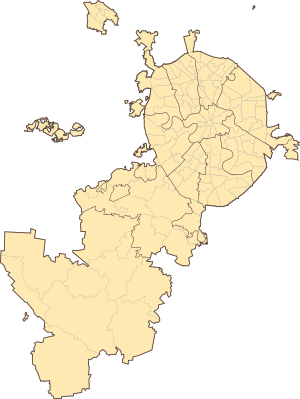Moscow zoo
| Moscow zoo | ||
|---|---|---|
| opening | 1864 | |
| organization | ||
|
Entrance to the Moscow Zoo |
||
| http://www.moscowzoo.ru/ | ||
|
|
||
Coordinates: 55 ° 45 ′ 43 " N , 37 ° 34 ′ 38" E
The Moscow Zoo ( Russian Московский зоопарк ) was opened in Moscow in 1864 , making it the oldest zoo in Russia .
location
The zoo is located a few 100 m to the west and outside the garden ring in the Presnensky district of the Central Administrative District at the Krasnopresnenskaya or Barrikadnaja metro stop ( ring line or line 7 ).
history
The zoo was founded by decree of Tsar Alexander II on the initiative of some professors from Moscow University . When it opened, the zoo was 10 hectares in size and housed 286 mostly native animals. During the Russian Civil War as a result of the October Revolution , 90 percent of the population was lost. In 1919 the zoo was nationalized and three years later (1922) it became the property of the city of Moscow, which has managed it ever since.
In 1926 the area was expanded to 18 hectares and the number of animals increased. The zoo's original buildings were made of wood and had elaborate folk decorations. In 1926 a science center was added to the zoo, laboratories were set up, and biologists and veterinarians were hired.
In 1935 the zookeeper Vera Tschaplina (1908–1994) became famous because she raised a lion cub in her home that was rejected by his mother. Tschaplina processed her memories of it and of her work at the Moscow Zoo in the book Vierbeinige Freunde und Zöglinge des Zoo , which was also published several times in German-speaking countries. The zoo recorded six million visitors during the war years 1941–1945.
In the 1970s and 1980s, neglected maintenance work left the zoo largely in disrepair. It was not until 1990 to 1997 that the zoo was fundamentally modernized under the personal supervision of the then mayor Yuri Luschkow and expanded to its current area of around 21.5 hectares. Part of these renovations was the redesign of the entrance area in the form of a castle and the creation of a pedestrian bridge that connects the old (1864) and new (1926) parts of the zoo. Before that, the two parts acted like separate zoos, as they were separated by Bolshaya Grusinskaya Street.
Over two million people visit the Moscow Zoo every year.
Duration
In the early days of its existence, the zoo received several significant donations: Tsar Alexander II donated an Indian elephant, Grand Duke Konstantin Romanov donated a rhinoceros and the Khedive of Egypt Ismail Pasha a zebra.
Today around 1000 animal species with around 8000 specimens are kept, including red wolves , sables and elephants . In the "Exotarium", a kind of aquarium , you can see underwater worlds including the fauna of tropical seas.
The alligator Saturn was a specialty . The animal was born in the wild in the United States in 1936 and brought to the Moscow Zoo in 1946 from the Soviet occupation zone . In Germany it is said to have belonged to the Berlin zoo , which was almost completely destroyed in the war, until 1945 . Two polar bears from the zoo's holdings were handed over to Tierpark Berlin : the female Tonja was presented to the public for the first time in 2011, Volodja in 2013.
Web links
Individual evidence
- ↑ a b 150 years of Moscow Zoo ( Memento of the original from January 14, 2018 in the Internet Archive ) Info: The archive link was automatically inserted and has not yet been checked. Please check the original and archive link according to the instructions and then remove this notice. , Sputniknews, accessed on January 13, 2018.
- ↑ a b c d e f Moscow Zoo History , rbth.com, accessed on January 13, 2018.
- ^ The name of the lion cub: Kinuli . It is formed from the Russian verb кинула (kinula) - to leave .
- ^ Catalog of the German National Library.
- ↑ The spoils of war Saturn - children can pester him sometimes , article in Stern from May 9, 2005, accessed on September 8, 2018.
- ↑ After Knut comes Wolodja: Berlin has a new polar bear , updated article on focus.de from August 23, 2013, accessed on September 8, 2018





